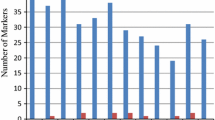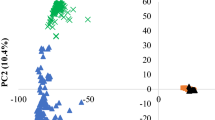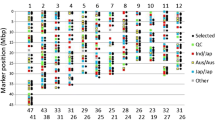Abstract
Key message
We present here the first curated collection of wild and cultivated African rice species. For that, we designed specific SNPs and were able to structure these very low diverse species.
Abstract
Oryza glaberrima, the cultivated African rice, is endemic from Africa. This species and its direct ancestor, O. barthii, are valuable tool for improvement of Asian rice O. sativa in terms of abiotic and biotic stress resistance. However, only a few limited studies about the genetic diversity of these species were performed. In the present paper, and for the first time at such extend, we genotyped 279 O. glaberrima, selected both for their impact in current breeding and for their geographical distribution, and 101 O. barthii, chosen based on their geographic origin, using a set of 235 SNPs specifically designed for African rice diversity. Using those data, we were able to structure the individuals from our sample in three populations for O. barthii, related to geography, and two populations in O. glaberrima; these two last populations cannot be linked however to any currently phenotyped trait. Moreover, we were also able to identify misclassification in O. glaberrima as well as in O. barthii and identified new form of O. sativa from the set of African varieties.







Similar content being viewed by others
References
Albar L, Ndjiondjop M-N, Esshak Z, Berger A, Pinel A, Jones M et al (2003) Fine genetic mapping of a gene required for Rice yellow mottle virus cell-to-cell movement. Theor Appl Genet 107:371–378
Barry MB, Pham JL, Noyer JL, Billot C, Courtois B, Ahmadi N (2007) Genetic diversity of the two cultivated rice species (O. sativa & O. glaberrima) in Maritime Guinea. Evidence for interspecific recombination. Euphytica 154:127–137
Bezançon G (1993) Le riz cultivé d’origine Africaine Oryza glaberrima Steud, et les formes sauvages et adventices apparentées : diversité, relations génétiques et domestication
Billot C, Droc G, Courtois B, Farouk A, Ahmadi N, Clément G et al (2007) HaplOryza—SNP analysis of the genetic diversity along the rice genome. http://www.generationcp.org/communications/programme-publications/project-briefs/doc_download/78-2006-executive-summaries
Dramé KN, Sanchez I, Gregorio G, Ndjiondjop M-N (2011) Suitability of a selected set of simple sequence repeats (SSR) markers for multiplexing and rapid molecular characterization of African rice (Oryza glaberrima Steud.). Afr J Biotechnol 10:6675–6685
Evanno G, Regnaut S, Goudet J (2005) Detecting the number of clusters of individuals using the software STRUCTURE: a simulation study. Mol Ecol 14:2611–2620
Excoffier L, Laval G, Schneider S (2005) Arlequin (version 3.0): an integrated software package for population genetics data analysis. Evolut Bioinform Online 1:47–50
Garavito A, Guyot R, Lozano J, Gavory F, Samain S, Panaud O et al (2010) A genetic model for the female sterility barrier between Asian and African cultivated rice species. Genetics 185:1425–1440
Garris AJ, Tai TH, Coburn J, Kresovich S, McCouch S (2005) Genetic structure and diversity in Oryza sativa L. Genetics 169:1631–1638
Glaszmann JC (1988) Geographic pattern of variation among Asian native rice cultivars (Oryza sativa L.) based on fifteen isozyme loci. Genome 30(5):782–792
Gridley HE, Jones MP, Wopereis-Pura M (2002) Development of new rice for Africa (NERICA) and participatory varietal selection. In: Breeding rainfed rice for drought-prone environments: integrating conventional and participatory plant breeding in South and Southeast Asia: proceedings of a DFID Plant Sciences Research Programme/IRRI Conference, pp 12–15
Gutiérrez AG, Carabalí SJ, Giraldo OX, Martínez CP, Correa F, Prado G et al (2010) Identification of a Rice stripe necrosis virus resistance locus and yield component QTLs using Oryza sativa × O. glaberrima introgression lines. BMC Plant Biol 10:6
He Z, Zhai W, Wen H, Tang T, Wang Y, Lu X et al (2011) Two evolutionary histories in the genome of rice: the roles of domestication genes. PLoS Genet 7:e1002100
Huang P, Molina J, Flowers JM, Rubinstein S, Jackson SA, Purugganan MD et al (2012) Phylogeography of Asian wild rice, Oryza rufipogon: a genome-wide view. Mol Ecol 21:4593–4604
Li H, Durbin R (2009) Fast and accurate long-read alignment with Burrows-Wheeler transform. Bioinformatics 25:1754–1760
Li H, Handsaker B, Wysoker A, Fennell T, Ruan J, Homer N et al (2009) The sequence alignment/Map format and SAMtools. Bioinformatics 25:2078–2079
Li Z-M, Zheng X-M, Ge S (2011) Genetic diversity and domestication history of African rice (Oryza glaberrima) as inferred from multiple gene sequences. Theor Appl Genet 123:21–31
Linares OF (2002) African rice (Oryza glaberrima): history and future potential. Proc Natl Acad Sci 99:16360–16365
Liu Q, Guo Y, Li J, Long J, Zhang B, Shyr Y (2012) Steps to ensure accuracy in genotype and SNP calling from Illumina sequencing data. BMC Genom 13:S8
Ma J, Bennetzen JL (2004) Rapid recent growth and divergence of rice nuclear genomes. Proc Natl Acad Sci USA 101:12404–12410
Martin M (2011) Cutadapt removes adapter sequences from high-throughput sequencing reads. EMBnet J 17:10–12
McKenna A, Hanna M, Banks E, Sivachenko A, Cibulskis K, Kernytsky A et al (2010) The Genome Analysis Toolkit: a MapReduce framework for analyzing next-generation DNA sequencing data. Genome Res 20:1297–1303
Milne I, Shaw P, Stephen G, Bayer M, Cardle L, Thomas WTB et al (2010) Flapjack–graphical genotype visualization. Bioinformatics 26:3133–3134
Murray SS (2004) Searching for the origins of African rice domestication. Antiquity 78
Nabholz B, Sarah G, Sabot F, Ruiz M, Adam H, Nidelet S, Ghesquière A, Santoni S, David J, Glemin S (2014) Transcriptome population genomics reveals severe bottleneck and domestication cost in the African rice (O. glaberrima). Mol Ecol. doi:10.1111/mec.12738
Nuijten E, van Treuren R, Struik PC, Mokuwa A, Okry F, Teeken B et al (2009) Evidence for the emergence of new rice types of interspecific hybrid origin in West African farmers’ fields. PLoS ONE 4:e7335
Orjuela J, Thiémélé D, Kolade O, Chéron S, Ghesquière A, Albar L (2013) A recessive resistance to Rice yellow mottle virus is associated with a rice homolog of the CPR5 gene, a regulator of active defence mechanisms. Mol Plant Microbe Interact 26(12):1455–1463
Perrier X, Flori A, Bonnot F (2003) Data analysis methods. In: Genetic diversity of cultivated tropical plants, pp 43–76
Portères R (1962) Primary cradles of agriculture in the African continent. J Afr Hist 3:195–210
Pritchard JK, Stephens M, Donnelly P (2000) Inference of population structure using multilocus genotype data. Genetics 155:945–959
Rousset F, Raymond M (1995) Testing heterozygote excess and deficiency. Genetics 140:1413–1419
Sano Y (1990) The genic nature of gamete eliminator in rice. Genetics 125:183–191
Second G (1982) Origin of the genic diversity of cultivated rice (Oryza spp.): study of the polymorphism scored at 40 isozyme loci. Jpn J Genet 57:25–57
Semon M, Nielsen R, Jones MP, McCouch SR (2005) The population structure of African cultivated rice Oryza glaberrima (Steud.): evidence for elevated levels of linkage disequilibrium caused by admixture with O. sativa and ecological adaptation. Genetics 169:1639–1647
Tamura K, Peterson D, Peterson N, Stecher G, Nei M, Kumar S (2011) MEGA5: molecular evolutionary genetics analysis using maximum likelihood, evolutionary distance, and maximum parsimony methods. Mol Biol Evol 28:2731–2739
Thiémélé D, Boisnard A, Ndjiondjop M-N, Chéron S, Séré Y, Aké S et al (2010) Identification of a second major resistance gene to Rice yellow mottle virus, RYMV2, in the African cultivated rice species, O. glaberrima. Theor Appl Genet 121:169–179
Thomson MJ, Zhao K, Wright M, McNally KL, Rey J, Tung C-W et al (2011) High-throughput single nucleotide polymorphism genotyping for breeding applications in rice using the BeadXpress platform. Mol Breed 29:875–886
Vaughan DA, Kadowaki K, Kaga A, Tomooka N (2005) On the phylogeny and biogeography of the genus oryza. Breed Sci 55:113–122
Vaughan DA, Lu B-R, Tomooka N (2008) The evolving story of rice evolution. Plant Sci 174:394–408
Zhao K, Tung C-W, Eizenga GC, Wright MH, Ali ML, Price AH et al (2011) Genome-wide association mapping reveals a rich genetic architecture of complex traits in Oryza sativa. Nat Commun 2:467
Zhu Q, Zheng X, Luo J, Gaut BS, Ge S (2007) Multilocus analysis of nucleotide variation of Oryza sativa and its wild relatives: severe bottleneck during domestication of rice. Mol Biol Evol 24:875–888
Acknowledgments
Authors want to thank Dr MN Ndjiondjop from AfricaRice Center (Cotonou, Benin) for her help in the African rice accessions choice, Dr Laurence Albar and Valérie Poncet for useful discussions, Mme Christine Tranchant for her informatics support, and Dr Timothy Tranbarger for his help in English corrections. All the analyses were performed on the Bioinformatics platform from IRD (http://bioinfo.ird.fr). This project was supported by a Grant from Agropolis Foundation (ArCad program) and from GRiSP project (MENERGEP NewFrontier program).
Conflict of interest
The authors declare no conflict of interest.
Author information
Authors and Affiliations
Corresponding author
Additional information
Communicated by Takuji Sasaki.
J. Orjuela and F. Sabot contributed equally to the work.
Electronic supplementary material
Below is the link to the electronic supplementary material.
Supplemental Fig. 1. STRUCTURE analysis for 279 O. glaberrima, 101 O. barthii accessions and 54 O. sativa estimated from 235 SNP loci, from K = 2 to K = 6.
Supplemental Fig. 2. Plots of log-likelihood and ΔK, from STRUCTURE analysis of the full set of sampled O. sativa, O. glaberrima and O. barthii (a, b); only for African accessions (c, d); O. barthii (e, f) and O. glaberrima (g, h).
Supplemental Fig. 3. STRUCTURE analysis for 266 O. glaberrima and 101 O. barthii accessions estimated from 235 SNP loci, from K = 2 to K = 6.
Supplemental Fig. 4. a STRUCTURE analysis estimated from 235 SNP loci for 101 O. barthii accessions, from K = 2 to K = 8. b Relationship between O. barthii accessions based on 70 % of ancestry between the 3 populations.
Supplemental Fig. 5. STRUCTURE analysis estimated from 235 SNP loci for 266 O. glaberrima, from K = 2 to K = 7.
Supplemental Table 1. Individual accessions used in the bulked sequencing.
Supplemental Table 2. Position and nature of the 384 SNPs used in the present study. The positions are based on the Oryza sativa ssp japonica cv Nipponbare MSU 6.1 sequence.
Supplemental Table 3. Origin, names and synonymic names of the plant material used in the current study. The accessions used in Li et al. (2011) are shown.
Rights and permissions
About this article
Cite this article
Orjuela, J., Sabot, F., Chéron, S. et al. An extensive analysis of the African rice genetic diversity through a global genotyping. Theor Appl Genet 127, 2211–2223 (2014). https://doi.org/10.1007/s00122-014-2374-z
Received:
Accepted:
Published:
Issue Date:
DOI: https://doi.org/10.1007/s00122-014-2374-z




